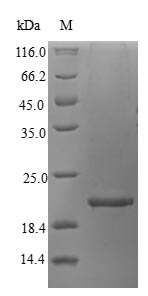Recombinant Atlantic salmon Vertebrate ancient opsin is expressed in E. coli and features an N-terminal 6xHis-B2M tag. This partial protein spans amino acids 1-75. Purification appears to reach levels exceeding 90%, as confirmed by SDS-PAGE analysis. The protein seems suitable for research applications and shows no detectable endotoxin levels.
Vertebrate ancient opsin is a light-sensitive protein that may be involved in non-visual photoreception. It likely plays a role in regulating circadian rhythms and other physiological processes influenced by light. This protein has drawn considerable interest from researchers trying to understand how light perception mechanisms evolved across different vertebrate species.
Potential Applications
Note: The applications listed below are based on what we know about this protein's biological functions, published research, and experience from experts in the field. However, we haven't fully tested all of these applications ourselves yet. We'd recommend running some preliminary tests first to make sure they work for your specific research goals.
Atlantic salmon vertebrate ancient opsin is a transmembrane GPCR that requires precise folding, proper membrane integration, chromophore (retinal) binding, and specific seven-transmembrane helix formation for its phototransduction activity. The E. coli expression system cannot provide the necessary membrane environment for this complex transmembrane protein. The partial fragment (1-75aa) represents only a small N-terminal portion of the full-length opsin (typically 350-400aa) and lacks the critical transmembrane domains and chromophore-binding sites. The large N-terminal 6xHis-B2M tag (∼12 kDa) is significantly larger than the opsin fragment itself (∼8 kDa) and will completely dominate the protein's properties. This construct cannot form any functional opsin structure or exhibit phototransduction activity.
1. Antibody Development and Validation
This application has limited utility. While antibodies can be generated against this specific 75aa N-terminal fragment, they will not recognize conformational epitopes of the full-length transmembrane opsin and may not bind the native protein in physiological contexts. The immune response will primarily target the dominant B2M tag rather than the small opsin fragment.
2. Structural and Biochemical Characterization Studies
Basic biophysical analysis can be performed, but will primarily reflect the B2M tag's properties rather than opsin structure. The 75aa fragment is too short and incomplete to provide meaningful insights into opsin biochemistry or evolution. Results will describe a misfolded tag-fusion protein rather than native opsin characteristics.
3. Tag-Based Detection Assay Development
This application is feasible but has limited research value. Assays can be developed targeting the His-B2M tags, but these will detect the tag fusion protein rather than providing insights into opsin biology. Such assays would be useful only for tracking this specific recombinant protein preparation.
Final Recommendation & Action Plan
This construct is fundamentally unsuitable for opsin research. The 75aa fragment represents only ~20% of the full-length opsin and lacks all critical functional domains (transmembrane helices, chromophore-binding site). The large B2M tag dominates the protein's properties, making any data biologically irrelevant to opsin function. The only limited applications are tag-specific detection and generating antibodies against this specific fragment. For authentic opsin research, use a full-length protein expressed in mammalian systems with proper membrane integration and chromophore binding capability.








